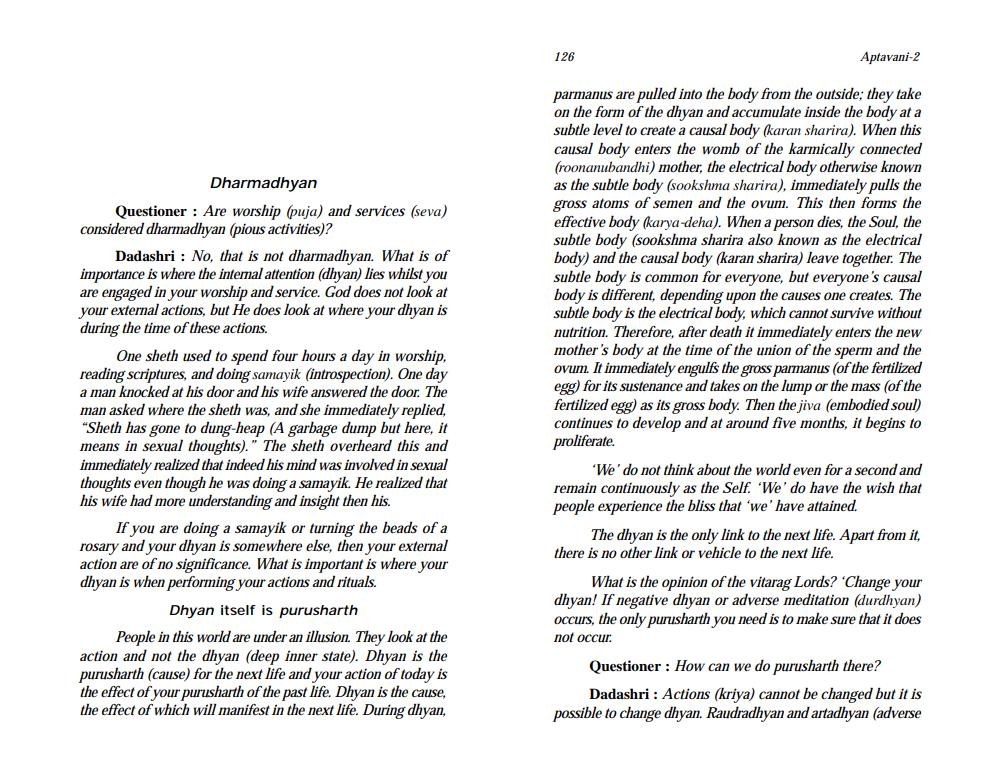________________
126
Aptavani-2
Dharmadhyan Questioner : Are worship (puja) and services (seva) considered dharmadhyan (pious activities)?
Dadashri : No, that is not dharmadhyan. What is of importance is where the internal attention (dhyan) lies whilst you are engaged in your worship and service. God does not look at your external actions, but He does look at where your dhyan is during the time of these actions.
One sheth used to spend four hours a day in worship, reading scriptures, and doing samayik (introspection). One day a man knocked at his door and his wife answered the door. The man asked where the sheth was, and she immediately replied, "Sheth has gone to dung-heap (A garbage dump but here, it means in sexual thoughts)." The sheth overheard this and immediately realized that indeed his mind was involved in sexual thoughts even though he was doing a samayik. He realized that his wife had more understanding and insight then his.
If you are doing a samayik or turning the beads of a rosary and your dhyan is somewhere else, then your external action are of no significance. What is important is where your dhyan is when performing your actions and rituals.
Dhyan itself is purusharth People in this world are under an illusion. They look at the action and not the dhyan (deep inner state). Dhyan is the purusharth (cause) for the next life and your action of today is the effect of your purusharth of the past life. Dhyan is the cause, the effect of which will manifest in the next life. During dhyan,
parmanus are pulled into the body from the outside; they take on the form of the dhyan and accumulate inside the body at a subtle level to create a causal body (karan sharira). When this causal body enters the womb of the karmically connected (roonanubandhi) mother, the electrical body otherwise known as the subtle body (sookshma sharira), immediately pulls the gross atoms of semen and the ovum. This then forms the effective body (karya-deha). When a person dies, the Soul, the subtle body (sookshma sharira also known as the electrical body) and the causal body (karan sharira) leave together. The subtle body is common for everyone, but everyone's causal body is different, depending upon the causes one creates. The subtle body is the electrical body, which cannot survive without nutrition. Therefore, after death it immediately enters the new mother's body at the time of the union of the sperm and the ovum. It immediately engulfs the gross parmanus (of the fertilized egg) for its sustenance and takes on the lump or the mass of the fertilized egg) as its gross body. Then the jiva (embodied soul) continues to develop and at around five months, it begins to proliferate.
'We do not think about the world even for a second and remain continuously as the Self. 'We' do have the wish that people experience the bliss that 'we' have attained.
The dhyan is the only link to the next life. Apart from it, there is no other link or vehicle to the next life.
What is the opinion of the vitarag Lords? 'Change your dhyan! If negative dhyan or adverse meditation (durdhyan) occurs, the only purusharth you need is to make sure that it does not occur.
Questioner: How can we do purusharth there?
Dadashri : Actions (kriya) cannot be changed but it is possible to change dhyan. Raudradhyan and artadhyan (adverse




